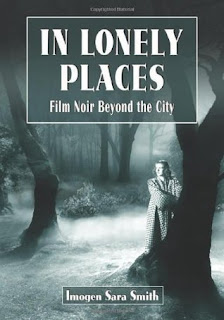In Lonely Places
Noir films are often set in cities, but that is not universally true, Imogen Sara Smith points out in her study, In Lonely Places: Film Noir Beyond The City. For fans of noir it's an essential read, as she discusses dozens of films in certain categories. I've seen many of the films, but a lot I haven't but can be put on my list.
"Noir was born from the mating of American pulp fiction, which came of age during the Depression with sordid tales of desperate lives, and German expressionist cinema, which developed in the turbulent Weimar era and was imported to Hollywood by immigrant directors, many fleeing Hitler." That's a standard description of noir. But she also has some more striking observations, "Noir found its fullest expression in America because the American psyche harbors a passion for independence, an impulse to be, in the words of Walt Whitman, "Loosed of limits, and imaginary where I list, my own master, total and absolute." With this desire for autonomy comes a corresponding fear of loneliness and exile."
Smith states some generalities about noir, which is a genre that many cinephiles argue about.
Smith divides her book in chapters in various categories, such as noir in the suburbs, or in small towns, on the Mexican border, in the desert, or on the beach. She discusses so many films that I can't remember them all, but some of them get more discussion than others. Out Of The Past, which I think is the best noir film, gets a lot of ink: "Jacques Tourneur's Out of the Past (1947), an essential film noir, opens with images of serene, rugged wilderness, framed in the style of Ansel Adams. Like the corpse-filled Raymond Chandler story sarcastically titled "No Crime in the Mountains," it proves that the stain of noir can be found anywhere."
For the Mexican border chapter, there is a long discussion of Orson Welles' Touch Of Evil. The desert chapter has a discourse on Ida Lupino's The Hitch-Hiker. A chapter about trapped women includes Human Desire, with Gloria Grahame (a familiar face in noir) as a battered wife. The small town chapter discusses Alfred Hitchcock's Shadow Of A Doubt. "Film noir is full of or small cities in the grip of omnipotent bosses; where the police are a private army rather than upholders of the law, where prostitution and gambling go on openly, and anyone who rocks the boat is asking for a beating or a bullet. But towns like Bedford Falls turn up in film noir, too, sometimes merely as clean-cut backdrops for menacing intruders, but also as false fronts concealing grubby secrets, bigotry and mob violence."
Smith also, controversially, includes a chapter on Western noir. Some film people think there's no such thing. She discusses the films of Anthony Mann, many of which starred James Stewart (Winchester '73, The Naked Spur, Bend In The River, The Man From Laramie) and several starring Robert Mitchum:
Smith also, controversially, includes a chapter on Western noir. Some film people think there's no such thing. She discusses the films of Anthony Mann, many of which starred James Stewart (Winchester '73, The Naked Spur, Bend In The River, The Man From Laramie) and several starring Robert Mitchum: This core of mystery is Mitchum's gift to his movies. He's always holding something back. Trying to figure him out is like dropping a stone into a well and listening for the splash. It falls and falls, and you never do find out how deep the well is."
Another actor who keeps popping up is Robert Ryan, an actor who isn't well remembered today. It seemed like every time she brought up a film he was in it.
Smith's passion for noir is evident, but she doesn't claim that every noir film is a classic, calling some of them overwrought or just silly. She also points out that the endings also betrays the theme, due to the censorship of the time: "Great noir endings are rarer than great noir films, since the Production Code and the studios' insistence on pandering to audiences usually mandated a moral lesson, a tidy resolution, and a last-moment lurch into optimism."
In Lonely Places is a fun book for film buffs, lucidly written and above all, a great list of films to see.



Comments
Post a Comment